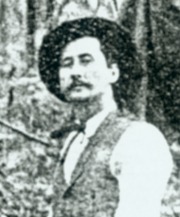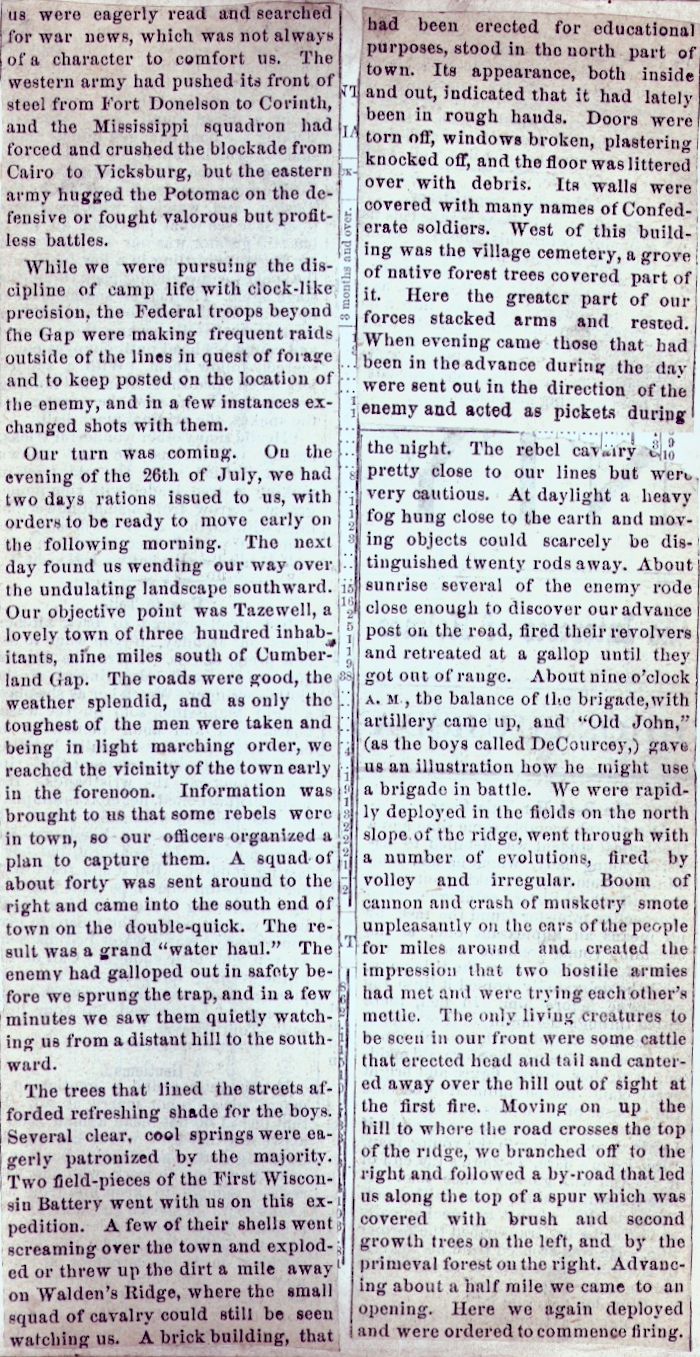| Camp & Field Page 22 | Camp & Field Index Page | 16th OVI Home Page | Camp & Field Page 24 |
The Camp & FieldArticles by Theodore Wolbach |
 Cpl. Theodore D. Wolbach |
The following image is taken from a book titled "Mortality and Statistics of the Census of 1850" in which it is believed retired Captain Rezin H. Vorhes, Company H, pasted over the pages a series of articles written by Cpl. Theodore D. Wolbach, Company E, titled "Camp and Field" and published, by chapter, in the Holmes County (Ohio) Republican newspaper from February 24, 1881 to August 17, 1882. The articles tell the story, in great detail and color, of the 16th OVI, from the inception of the 3-year regiment in October, 1861, through all its camps, battles and marches until it was disbanded on October 31, 1864. The articles pasted in the Vorhes book cover the first 35 chapters, published through October 20, 1881. All the remaining chapters were recently found in a Holmes County library by researcher Rob Garber who obtained copies, performed the transcriptions and provided to this website and which are also presented here, thus providing the complete work by Theodore Wolbach.
Throughout these articles click on the underlined white text for additional details.
The webauthor thanks 16th Ohio descendant Rob Garber for his excellent research on the Camp And Field articles and for performing the tedious digital transcription of those articles found on each page. The transcriptions were made to reflect the original articles verbatim, misspellings and all. Rob is the 3rd great nephew of Capt. William Buchanan, Company F, 16th Ohio, who served in the 90-day regiment as a private, re-enlisting in the three year regiment, and eventually making the rank of Captain of Company F. Thanks Rob!
Page 23 - Chapter 14 - July, 1862
 |
us were eagerly read and searched for war news, which was not always of a character to comfort us. The western army had pushed its front of steel from Fort Donelson to Corinth, and the Mississippi squadron had forced and crushed the blockade from Cairo to Vicksburg, but the eastern army hugged the Potomac on the defensive or fought valorous but profitless battles. While we were pursuing the discipline of camp life with clock-like precision, the Federal troops beyond the Gap were making frequent raids outside of the lines in quest of forage and to keep posted on the location of the enemy, and in a few instances exchanged shots with them. Our turn was coming. On the evening of the 26th of July, we had two days rations issued to us, with orders to be ready to move early on the following morning. The next day found us wending our way over the undulating landscape southward. Our objective point was Tazewell, a lovely town of three hundred inhabitants, nine miles south of Cumberland Gap. The roads were good, the weather splendid, and as only the toughest of the men were taken and being in light marching order, we reached the vicinity of the town early in the forenoon. Information was brought to us that some rebels were in town, so our officers organized a plan to capture them. A squad of about forty was sent around to the right and came into the south end of the town on the double-quick. The result was a grand The trees that lined the streets afforded refreshing shade for the boys. Several clear, cool springs were eagerly patronized by the majority. Two field-pieces of the First Wisconsin Battery went with us on this expedition. A few of their shells went screaming over the town and exploded or threw up the dirt a mile away on Walden's Ridge, where the small squad of cavalry could still be seen watching us. A brick building, that |
had been erected for educational purposes, stood in the north part of the town. Its appearance, both inside and out, indicated that it had lately been in rough hands. Doors were town off, windows broken, plastering knocked off, and the floor was littered over with debris. It walls were covered with many names of Confederate soldiers. West of this building was the village cemetery, a grove of native forest trees covered part of it. Here the greater part of our forces stacked arms and rested. When evening came those that had been in the advance during the day were sent out in the direction of the enemy and acted as pickets during the night. The rebel cavalry were pretty close to our lines but were very cautious. At daylight a heavy fog hung close to the earth and moving objects could scarcely be distinguished twenty rods away. About sunrise several of the enemy rode close enough to discover our advance post on the road, fired their revolvers and retreated at a gallop until they got out of range. About nine o'clock A.M., the balance of the brigade, with artillery came up, and |
| Camp & Field Page 22 | Camp & Field Index Page | 16th OVI Home Page | Camp & Field Page 24 |